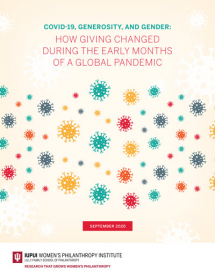Research explores household giving in response to COVID-19, highlights gender differences
A new report from the Women’s Philanthropy Institute (WPI), COVID-19, Generosity, and Gender: How Giving Changed During the Early Months of a Global Pandemic, explores how men and women gave in response to the pandemic and how their overall giving changed in spring 2020. The findings signal the growing prevalence of new, more expansive forms of philanthropy.
The report, which is funded by a grant from the Bill & Melinda Gates Foundation, found that the majority of U.S. households engaged in charitable activity in response to the pandemic during the early months of the crisis. Almost one-third of households gave directly. Nearly half—particularly younger generations—gave indirectly, for example, by ordering take-out from a local restaurant or continuing to pay their hair stylist without receiving any services. This type of indirect giving is in line with a broader reimagining of philanthropy that was underway prior to COVID-19.
“The pandemic has upended every aspect of our lives, philanthropy included. This report signals a new kind of generosity as people give back to their communities in more imaginative ways, despite facing tremendous challenges,” said Jeannie Sager, director of the Women’s Philanthropy Institute. “To tap into this generosity, nonprofits and fundraisers should consider providing supporters with creative ways to support the organization’s mission and connect with one another digitally, which is especially valued by women donors.”
The report also found that the majority of U.S. households maintained their overall giving levels during the initial months of the pandemic. Among those who reported changes, households were more likely to decrease their giving in response to the crisis than to increase it.
Additionally, the study found that specific elements of the pandemic, such as uncertainty about the economic impacts and further spread of the virus, affected households’ giving during the early months of the crisis; these elements affected giving to different degrees based on gender and marital status. While single women were more likely than single men and married/partnered couples to report that they decreased their giving overall in response to the crisis, this difference was generally not statistically significant. However, when asked how particular aspects of the pandemic affected their giving, single women were significantly more likely than single men to indicate their giving decreased due to factors like economic uncertainty and reduced interaction with their community.
“Women in particular may be feeling the effects of COVID-19 on their giving. As WPI research has shown, women are typically more likely to give than men. It appears that the circumstances of this crisis — which disproportionately affect women economically and disrupt the ability to network and connect — may be putting a strain on their giving,” said Debra Mesch, Ph.D., Professor of Philanthropic Studies and Eileen Lamb O'Gara Chair in Women's Philanthropy at the Indiana University Lilly Family School of Philanthropy. “Taken as a whole, the findings from this initial research indicate that generosity is alive, well and evolving during a global pandemic.”
Key findings from the full report include:
1. Around one-third of U.S. households gave directly to charitable organizations, individuals or businesses in response to the COVID-19 pandemic during the initial months of the crisis.
2. Nearly half of households gave indirectly in response to the pandemic during the early months of the crisis (for example, by ordering takeout to support restaurants and their employees or continuing to pay individuals and businesses for services they could not render).
3. The majority of U.S. households’ overall giving stayed the same during the initial months of the COVID-19 pandemic; however, those that reported changes were more likely to say their giving decreased rather than increased as a result of the crisis.
4. Households were more likely to decrease than increase their giving as a result of conditions present during the early months of the pandemic (such as uncertainty about the spread of the virus and further economic impacts).
5. Single women were more likely than single men and married/partnered couples to decrease their giving as a result of specific elements of the COVID-19 pandemic during the initial months of the crisis.
About the Women’s Philanthropy Institute
The Women’s Philanthropy Institute (WPI) is part of the Indiana University Lilly Family School of Philanthropy at IU Indianapolis. WPI increases understanding of women’s philanthropy through rigorous research and education, interpreting and sharing these insights broadly to improve philanthropy. By addressing significant and groundbreaking research questions and translating that research into increased understanding and improvements in practice, WPI helps to leverage new and expanded resources for the common good.
About the Indiana University Lilly Family School of Philanthropy
The Lilly Family School of Philanthropy at IU Indianapolis is dedicated to improving philanthropy to improve the world by training and empowering students and professionals to be innovators and leaders who create positive and lasting change. The school offers a comprehensive approach to philanthropy through its academic, research and international programs and through The Fund Raising School, Lake Institute on Faith & Giving, the Mays Family Institute on Diverse Philanthropy and the Women’s Philanthropy Institute. Follow us on Twitter, LinkedIn, or Instagram, and “Like” us on Facebook.


